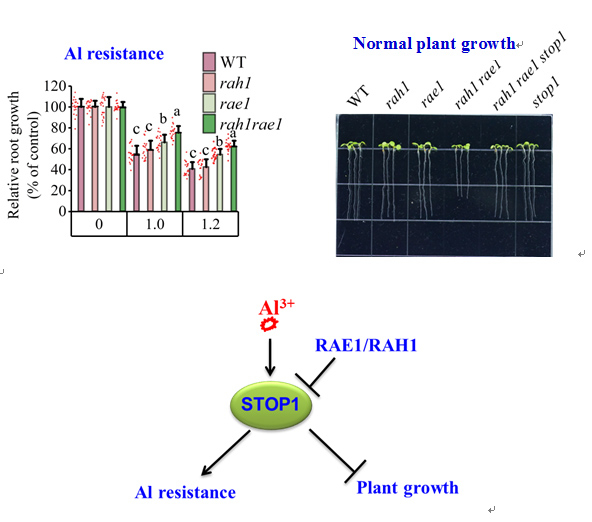How to balance aluminum resistance and normal plant growth?
Scientists at the Shanghai Center for Plant Stress Biology, Center for Excellence in Molecular Plant Sciences of the Chinese Academy of Sciences discovered that F-box proteins RAH1 and RAE1 play redundant roles in the regulation of STOP1 stability, and the RAH1/RAE1-mediated STOP1 degradation is important for the balance of aluminum resistance and plant growth in Arabidopsis thaliana.
Aluminum (Al) toxicity is a major limiting factor for crop production on acid soils, which consists of over 30% of the world’s arable land. Plants have evolved various mechanisms to detoxify Al. The C2H2-type zinc finger transcription factor STOP1 plays a crucial role in Al resistance by regulating the expression of a set of Al-resistance genes in Arabidopsis thaliana. The F-box protein RAE1 was recently demonstrated to be involved in the regulation of Al resistance by the mediation of STOP1 ubiquitination and degradation. There is one unique homolog of RAE1, RAH1 (RAE1 homolog 1), in Arabidopsis. Nevertheless, it is unclear whether RAH1 plays a similar role in the regulation of STOP1 stability and Al resistance to RAE1. Likewise, there are reports showing that plants need to modulate the expression levels of some key factors to balance plant growth and stress tolerance. Whether STOP1 plays a role in the balance of Al resistance and plant growth remains unknown.
Qiu Fang and colleagues in Chao-Feng Huang’s demonstrate that RAH1 can directly interact with STOP1 and promote the ubiquitination and degradation of STOP1. They found that mutation of RAH1 in rae1 but not in wild-type background is able to increase the STOP1 level and Al resistance compared to rae1 mutant, suggesting that RAH1 plays an unequally redundant role with RAE1 in the regulation of STOP1 protein and Al resistance and RAE1 is the major player. The more important role of RAE1 than RAH1 in the regulation of STOP1 accumulation is likely attributed to the different tissue-specific expression of RAH1 and RAE1. These observations also suggest that RAE1 instead of RAH1 orthologs should be the prior targets for mutation to improve crop resistance to Al in the future.
Interestingly, rah1rae1 double mutant shows reduced plant growth compared to WT and single mutants under normal conditions, and introduction of stop1 mutation into the double mutant background can rescue its reduced plant growth phenotype. Their results thus reveal that the optimal level of STOP1 modulated by RAH1 and RAE1 is important for the balance of Al resistance and plant growth.
Funding: This work was supported by the National Natural Science Foundation of China (Grant No. 31870223 to C.-F. H.), the funding from the Shanghai Center for Plant Stress Biology, Chinese Academy of Sciences, and National Key Laboratory of Plant Molecular Genetics
Link to this article: https://onlinelibrary.wiley.com/doi/10.1111/tpj.15181
